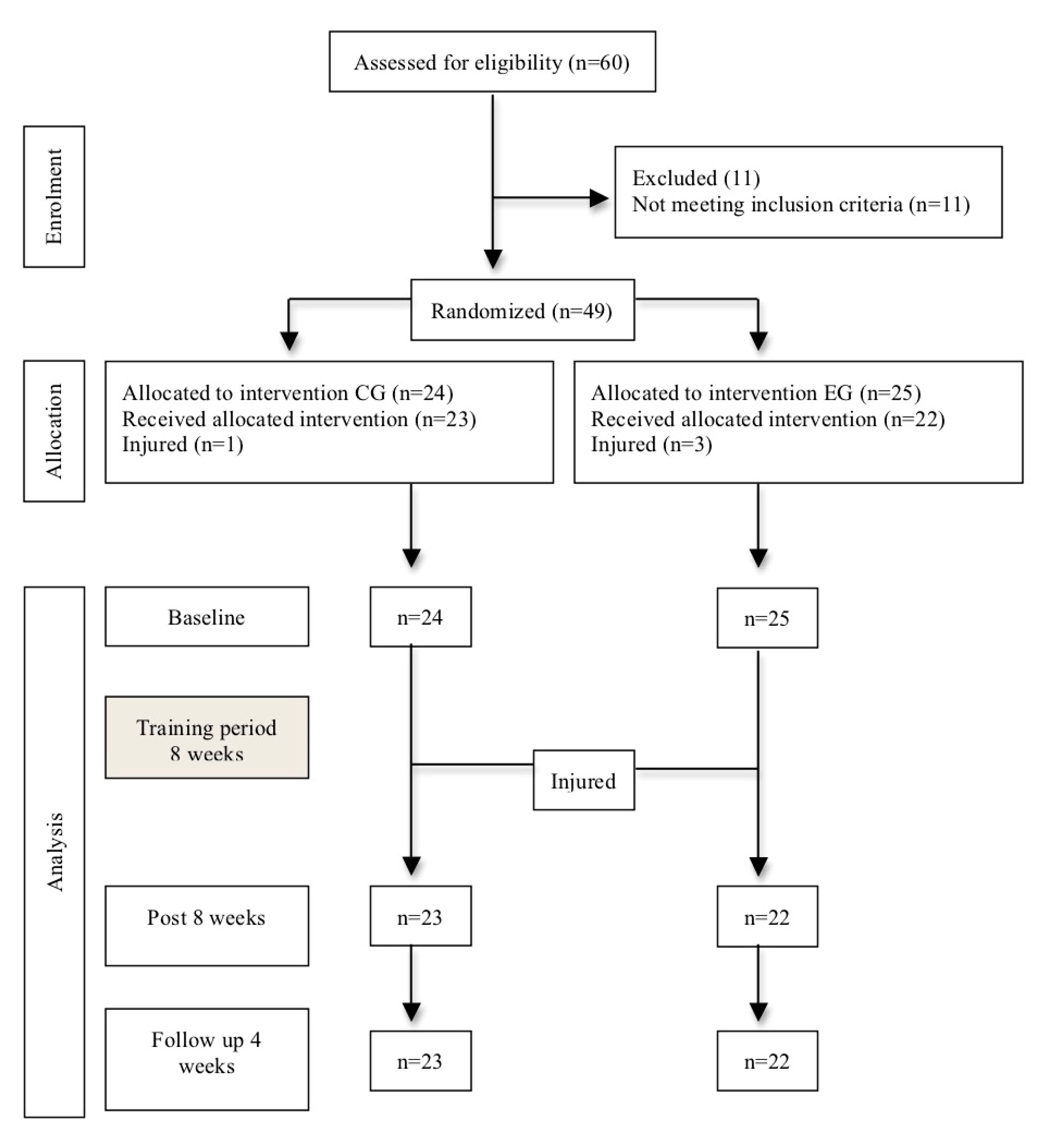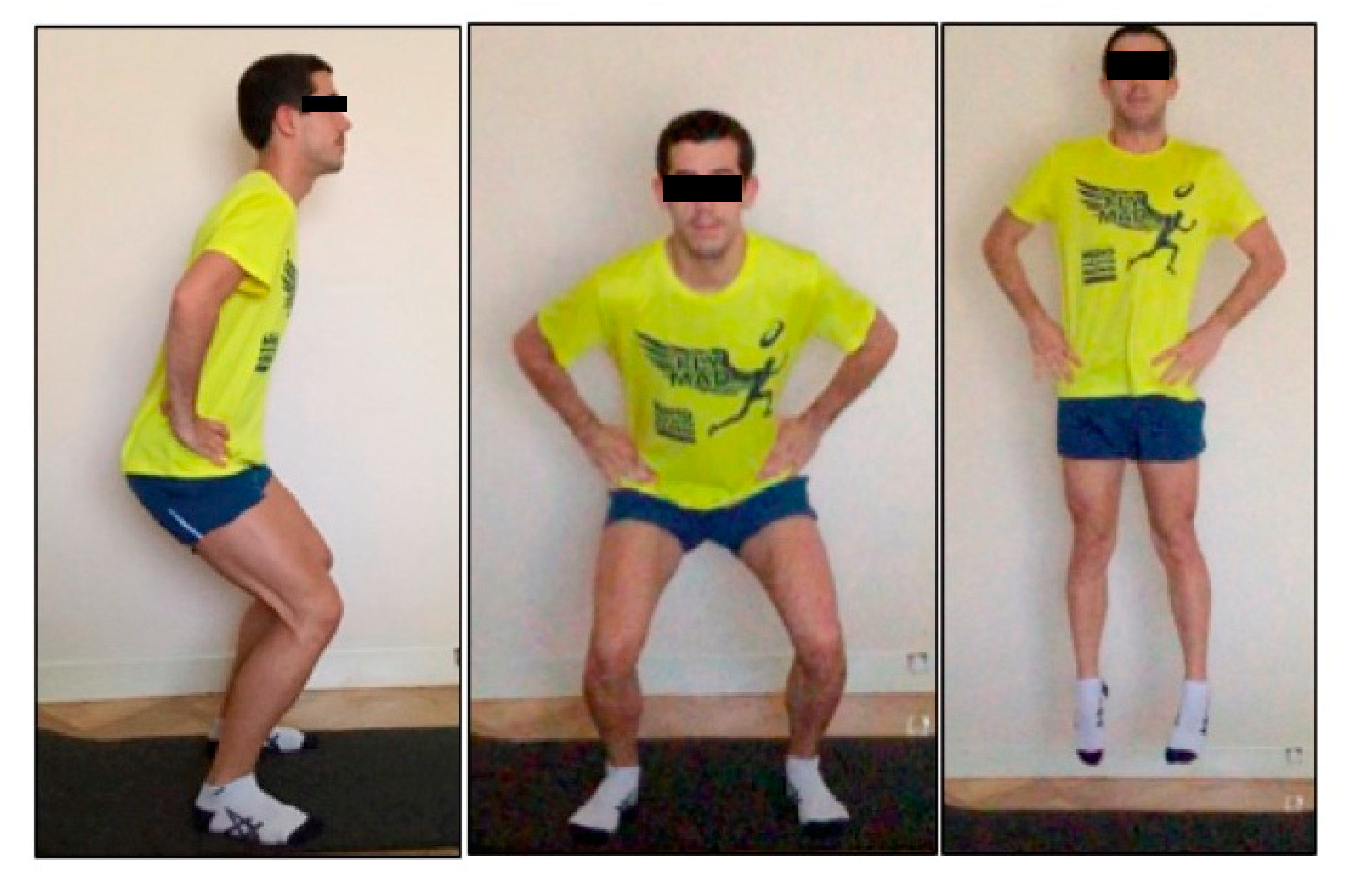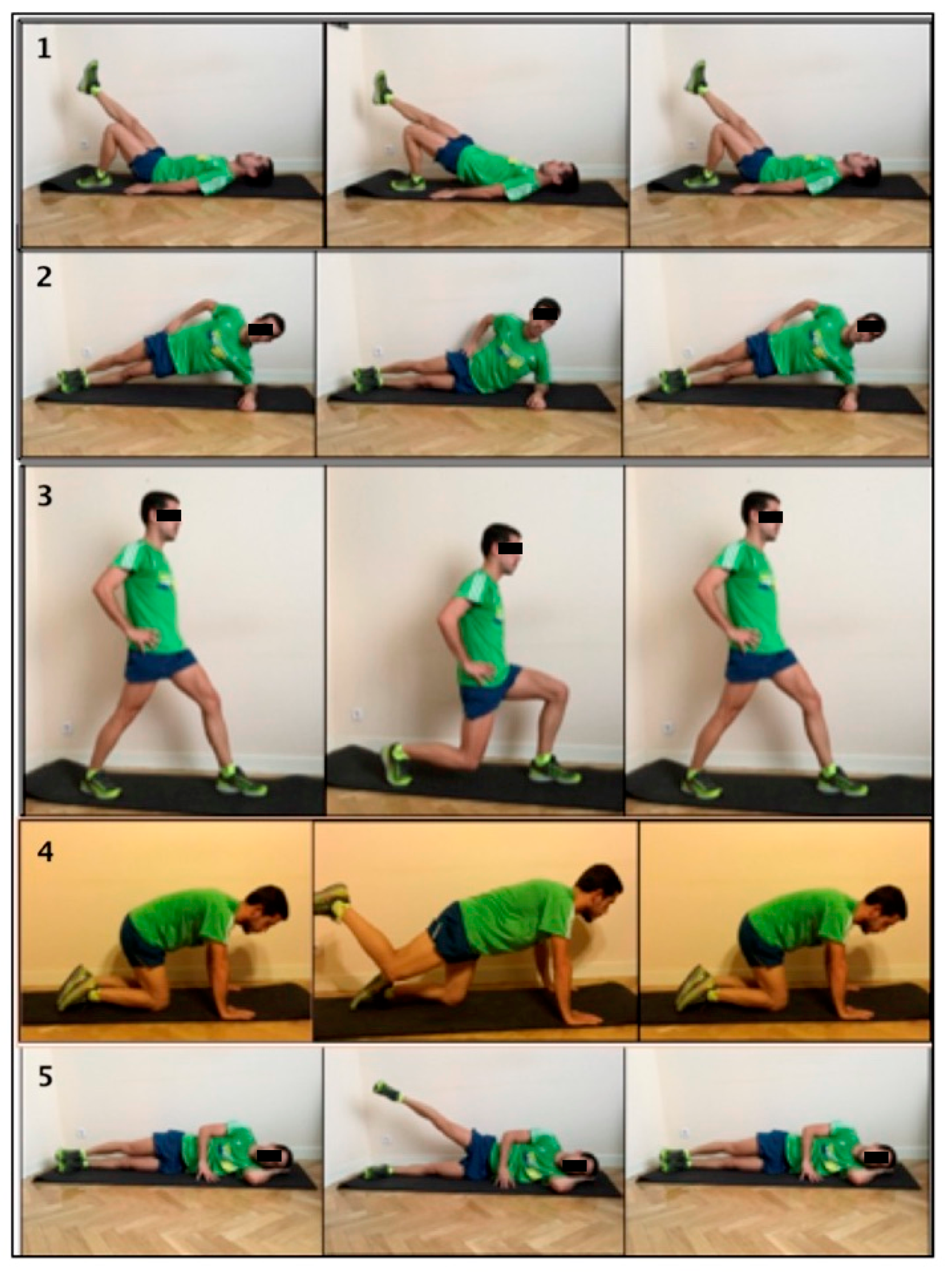Effects of a Gluteal Muscles Specific Exercise Program on the Vertical Jump
Abstract
1. Introduction
2. Materials and Methods
2.1. Study Design
2.2. Participants
2.3. Randomization
2.4. Outcomes
2.5. Intervention
2.6. Sample Size Calculation
2.7. Statistical Analysis
3. Results
3.1. Jump Height
3.2. Fight Time
3.3. Speed
3.4. Power
4. Discussion
5. Conclusions
Author Contributions
Funding
Acknowledgments
Conflicts of Interest
References
- Plummer, H.A.; Oliver, G.D. The relationship between gluteal muscle activation and throwing kinematics in baseball and softball catchers. J. Strength Cond. Res. 2014, 28, 87–96. [Google Scholar] [CrossRef] [PubMed]
- Jacobson, B.H.; Monaghan, T.P.; Sellers, J.H.; Conchola, E.C.; Pope, Z.K.; Glass, R.G. Acute Effect of Biomechanical Muscle Stimulation on the Counter-Movement Vertical Jump Power and Velocity in Division I Football Players. J. Strength Cond. Res. 2017, 31, 1259–1264. [Google Scholar] [CrossRef] [PubMed]
- Blache, Y.; Monteil, K. Effects of spine flexion and erector spinae maximal force on vertical squat jump height: A computational simulation study. Sport Biomech. 2015, 14, 81–94. [Google Scholar] [CrossRef] [PubMed]
- Mike, J.N.; Cole, N.; Herrera, C.; VanDusseldorp, T.; Kravitz, L.; Kerksick, C.M. The Effects of Eccentric Contraction Duration on Muscle Strength, Power Production, Vertical Jump, and Soreness. J. Strength Cond. Res. 2017, 31, 773–786. [Google Scholar] [CrossRef]
- Kirmizigil, B.; Ozcaldiran, B.; Colakoglu, M. Effects of three different stretching techniques on vertical jumping performance. J. Strength Cond. Res. 2014, 28, 1263–1271. [Google Scholar] [CrossRef]
- Campos, G.E.R.; Luecke, T.J.; Wendeln, H.K.; Toma, K.; Hagerman, F.C.; Murray, T.F.; Ragg, K.E.; Ratamess, N.A.; Kraemer, W.J.; Staron, R.S. Muscular adaptations in response to three different resistance-training regimens: Specificity of repetition maximum training zones. Eur. J. Appl. Physiol. 2002, 88, 50–60. [Google Scholar] [CrossRef]
- Caia, J.; Weiss, L.W.; Chiu, L.Z.F.; Schilling, B.K.; Paquette, M.R.; Relyea, G.E. Do Lower-Body Dimensions and Body Composition Explain Vertical Jump Ability? J. Strength Cond. Res. 2016, 30, 3073–3083. [Google Scholar] [CrossRef]
- Križaj, J.; Rauter, S.; Vodičar, J.; Hadžić, V.; Šimenko, J. Predictors of vertical jumping capacity in soccer players. Isokinet. Exerc. Sci. 2019, 27, 9–14. [Google Scholar] [CrossRef]
- Bulgan, C. The Relationship between Isokinetic Knee Strength and Squat Jump Performance. Anthropology 2016, 24, 440–444. [Google Scholar] [CrossRef]
- Clark, R.; Bryant, A.; Culgan, J.-P.; Hartley, B. The effects of eccentric hamstring strength training on dynamic jumping performance and isokinetic strength parameters: A pilot study on the implications for the prevention of hamstring injuries. Phys. Ther. Sport 2005, 6, 67–73. [Google Scholar] [CrossRef]
- Blache, Y.; Monteil, K. Influence of lumbar spine extension on vertical jump height during maximal squat jumping. J. Sports Sci. 2014, 32, 642–651. [Google Scholar] [CrossRef] [PubMed]
- Jenkins, D. Hollinshead’s Functional Anatomy of the Limbs and Back, 9th ed.; Saunders, W.B., Ed.; WB Saunders: Phyladelphia, PA, USA; London, UK; Boston, MA, USA, 2009; ISBN 9781416049807. [Google Scholar]
- Wagner, T.; Behnia, N.; Ancheta, W.-K.L.; Shen, R.; Farrokhi, S.; Powers, C.M. Strengthening and Neuromuscular Reeducation of the Gluteus Maximus in a Triathlete with Exercise-Associated Cramping of the Hamstrings. J. Orthop. Sport Phys. Ther. 2010, 40, 112–119. [Google Scholar] [CrossRef] [PubMed]
- Stojanović, E.; Ristić, V.; McMaster, D.T.; Milanović, Z. Effect of Plyometric Training on Vertical Jump Performance in Female Athletes: A Systematic Review and Meta-Analysis. Sport Med. 2017, 47, 975–986. [Google Scholar] [CrossRef]
- Vanrenterghem, J.; De Clercq, D.; Cleven, P. Van Necessary precautions in measuring correct vertical jumping height by means of force plate measurements. Ergonomics 2001, 44, 814–818. [Google Scholar] [CrossRef] [PubMed]
- Bogataj, Š.; Pajek, M.; Hadžić, V.; Andrašić, S.; Padulo, J.; Trajković, N. Validity, Reliability, and Usefulness of My Jump 2 App for Measuring Vertical Jump in Primary School Children. Int. J. Environ. Res. Public Health 2020, 17, 3708. [Google Scholar] [CrossRef]
- Gallardo-Fuentes, F.; Gallardo-Fuentes, J.; Ramírez-Campillo, R.; Balsalobre-Fernández, C.; Martínez, C.; Caniuqueo, A.; Cañas, R.; Banzer, W.; Loturco, I.; Nakamura, F.Y.; et al. Intersession and Intrasession Reliability and Validity of the My Jump App for Measuring Different Jump Actions in Trained Male and Female Athletes. J. Strength Cond. Res. 2016, 30, 2049–2056. [Google Scholar] [CrossRef]
- Cruvinel-Cabral, R.M.; Oliveira-Silva, I.; Medeiros, A.R.; Claudino, J.G.; Jiménez-Reyes, P.; Boullosa, D.A. The validity and reliability of the “My Jump App” for measuring jump height of the elderly. PeerJ 2018, 6, e5804. [Google Scholar] [CrossRef]
- Balsalobre-Fernández, C.; Glaister, M.; Lockey, R.A. The validity and reliability of an iPhone app for measuring vertical jump performance. J. Sports Sci. 2015, 33, 1574–1579. [Google Scholar] [CrossRef]
- Hartmann, H.; Wirth, K.; Klusemann, M.; Dalic, J.; Matuschek, C.; Schmidtbleicher, D. Influence of squatting depth on jumping performance. J. Strength Cond. Res. 2012, 26, 3243–3261. [Google Scholar] [CrossRef]
- Marián, V.; Katarína, L.; Dávid, O.; Matúš, K.; Simon, W. Improved Maximum Strength, Vertical Jump and Sprint Performance after 8 Weeks of Jump Squat Training with Individualized Loads. J. Sports Sci. Med. 2016, 15, 492–500. [Google Scholar]
- Reiman, M.P.; Bolgla, L.A.; Loudon, J.K. A literature review of studies evaluating gluteus maximus and gluteus medius activation during rehabilitation exercises. Physiother. Theory Pract. 2012, 28, 257–268. [Google Scholar] [CrossRef] [PubMed]
- Son, C.; Stewart, A.; Ward, J.; Farrar, K. Lower Body Strength-Training Versus Proprioceptive Exercises on Vertical Jump Capacity: A Feasibility Study. J. Chiropr. Med. 2018, 17, 7–15. [Google Scholar] [CrossRef] [PubMed]
- Haddas, R.; Hooper, T.; James, C.R.; Sizer, P.S. Volitional Spine Stabilization During a Drop Vertical Jump From Different Landing Heights: Implications for Anterior Cruciate Ligament Injury. J. Athl. Train. 2016, 51, 1003–1012. [Google Scholar] [CrossRef]
- Crow, J.F.; Buttifant, D.; Kearny, S.G.; Hrysomallis, C. Low load exercises targeting the gluteal muscle group acutely enhance explosive power output in elite athletes. J. Strength Cond. Res. 2012, 26, 438–442. [Google Scholar] [CrossRef] [PubMed]
- Healy, R.; Harrison, A.J. The effects of a unilateral gluteal activation protocol on single leg drop jump performance. Sport Biomech. 2014, 13, 33–46. [Google Scholar] [CrossRef]
- Harrison, A.J.; McCABE, C. The effect of a gluteal activation protocol on sprint and drop jump performance. J. Sports Med. Phys. Fit. 2017, 57, 179–188. [Google Scholar] [CrossRef]
- Baratta, R.; Solomonow, M.; Zhou, B.H.; Letson, D.; Chuinard, R.; D’Ambrosia, R. Muscular coactivation. Am. J. Sports Med. 1988, 16, 113–122. [Google Scholar] [CrossRef]
- Comyns, T.; Kenny, I.; Scales, G. Effects of a Low-Load Gluteal Warm-Up on Explosive Jump Performance. J. Hum. Kinet. 2015, 46, 177–187. [Google Scholar] [CrossRef]
- Dal Pupo, J.; Detanico, D. Kinetic parameters as determinants of vertical jump performance. Braz. J. Kinanthropometry Hum. Perform. 2011, 1, 41–51. [Google Scholar]
- Newton, R.U.; Kraemer, W.J.; Häkkinen, K. Effects of ballistic training on preseason preparation of elite volleyball players. Med. Sci. Sports Exerc. 1999, 31, 323–330. [Google Scholar] [CrossRef]
- Battaglia, G.; Paoli, A.; Bellafiore, M.; Bianco, A.; Palma, A. Influence of a sport-specific training background on vertical jumping and throwing performance in young female basketball and volleyball players. J. Sports Med. Phys. Fit. 2014, 54, 581–587. [Google Scholar]



| Variables | Total Group N = 45 | Control Group N = 23 | Experimental Group N = 22 | p |
|---|---|---|---|---|
| Sex/F–M in % | 26–19 (57.8%–42.2%) | 14–9 (60.8%–29.2%) | 12–10 (54.6%–45.4%) | 0.767 |
| Age/Years/Max.-min. * | 27.33 (3.55) 19–35 | 27.43 (3.89) 19–33 | 27.23 (3.35) 24–35 | 0.847 |
| Size/m * | 1.70 (0.09) | 1.70 (0.08) | 1.70 (0.09) | 0.984 |
| Weight/kg * | 63.04 (9.24) | 63.35 (9.00) | 62.71 (9.60) | 0.821 |
| BMI/kg:m2 * | 21.52 (1.88) | 21.63 (1.83) | 21.41 (1.96) | 0.696 |
| Length mmii/cm * | 80.16 (4.73) | 79.76 (4.64) | 80.59 (4.90) | 0.563 |
| Femur length/cm * | 40.56 (3.19) | 40.19 (3.37) | 40.95 (3.03) | 0.432 |
| Tibia length/cm * | 38.27 (2.70) | 38.15 (2.56) | 38.40(2.89) | 0.754 |
| Thigh diameter/d = 2r * | 50.34 (4.37) | 50.28 (2.21) | 50.41 (5.91) | 0.919 |
| Triceps diameter/d = 2r * | 35.46 (3.10) | 35.32 (2.30) | 35.60 (3.81) | 0.771 |
| SJ pre/cm * | 24.05 (10.37) | 22.61 (10.20) | 25.56 (10.58) | 0.347 |
| Speed pre/m:s * | 1.05 (0.26) | 1.02 (0.26) | 1.09 (0.25) | 0.387 |
| Power pre/W * | 415.85 (97.97) | 410.67 (91.71) | 421.27 (106.02) | 0.721 |
| FT pre/ms * | 467.04 (106.69) | 418.43 (108.58) | 517.86 (78.78) | 0.405 |
| Smoker/yes-no in % | 3–42 (6.7%–93.3%) | 1–22 (4.3%–95.7%) | 2–20 (9%–91%) | |
| Sport/no. in %: | ||||
| Football Basketball Volleyball | 20 (44.4%) 12 (26.7%) 13 (28.9%) | 10 (43.5%) 6 (26.1%) 7 (30.4%) | 10 (45.6%) 6 (27.2%) 6 (27.2%) | |
| Sleep hours/hours * | 7.11 (0.82) | 7.13 (0.78) | 7.09 (0.88) |
| Group * | Pre Intervention | Post Intervention | Follow-Up | % RC |
|---|---|---|---|---|
| Control (cm) | 22.61 (10.20) | 23.41 (8.86) | 23.31 (9.09) | 3.09 |
| Experimental (cm) | 25.56 (10.58) | 30.14 (8.32) | 26.43 (10.57) | 17.15 |
| Within-Group Difference in Change Score †,‡ | ||||
| Time Interaction Per Group | F(2,86) = 5.174, p = 0.014; η2 = 0.10 | |||
| Intra Group Time Differences | ||||
| Control/pre-post; pre-follow-up | −0.80 (−3.55, 1.94) | −0.70 (−2.29, 0.89) | ||
| Experimental/pre-post; pre-follow-up | −4.58 (−7.38, −1.77) ~ | −0.87 (−2.48, 0.75) | ||
| Inter group time differences ‡ pre-post; pre-follow-up | 3.77 (0.50, 7.04) ~ | 0.17 (−1.67, 2.01) | ||
| Group * | Pre Intervention | Post Intervention | Follow-Up | % RC | |
|---|---|---|---|---|---|
| Control (ms) | 418.43 (108.58) | 431.69 (93.39) | 433.17 (98.15) | 3.52 | |
| Experimental (ms) | 517.86 (76.78) | 579.77 (93.39) | 531.72 (43.98) | 7.98 | |
| Within-Group Difference in Change Score †,‡ | |||||
| Time Interaction Per Group | F(2,86) = 8.835, p < 0.001; η2 = 0.17 | ||||
| Intra Group Time Differences | |||||
| Control/pre-post; pre-follow-up | −13.26 (−28.36, 1.84) | −14.73 (−54.91, 25.43) | |||
| Experimental/pre-post; pre-follow-up | −16.50 (−31.94, −1.05) ~ | −14.59 (−56.66, −26.59) | |||
| Inter group time differences ‡ pre-post; pre-follow-up | 3.23 (−14.24,30.72) ~ | −0.14 (1.75, 52.02) | |||
| Group * | Pre Intervention | Post Intervention | Follow-Up | % RC |
|---|---|---|---|---|
| Control (m/s) | 1.02 (0.26) | 1.05 (0.22) | 1.04 (0.23) | 1.83 |
| Experimental (m/s) | 1.09 (0.25) | 1.17 (0.27) | 1.11 (0.25) | 1.96 |
| Within-Group Difference in Change Score †,‡ | ||||
| Time Interaction Per Group | F(2,86) = 5.130, p = 0.008; η2 = 0.12 | |||
| Intra Group Time Differences | ||||
| Control/pre-post; pre-follow-up | −0.02 (−0.06, 0.01) | −0.02 (−0.06, 0.01) | ||
| Experimental/pre-post; pre-follow-up | −0.08 (−0.12, −0.04) § | −0.02 (−0.05, 0.01) | ||
| Inter group time differences ‡ pre-post; pre-follow-up | 0.05 (0.01, 0.10) ~ | −0.00 (−0.04, 0.03) | ||
| Group * | Pre Intervention | Post Intervention | Follow-Up | %RC | |
|---|---|---|---|---|---|
| Control (watts) | 410.67 (91.71) | 416.42 (96.85) | 412.00 (83.90) | 0.32 | |
| Experimental (watts) | 421.27 (106.02) | 455.35 (97.50) | 426.77 (103.17) | 4.43 | |
| Within-Group Difference in Change Score †,‡ | |||||
| Time Interaction Per Group | F(2,86) = 3.733, p = 0.028; η2 = 0.08 | ||||
| Intra Group Time Differences | |||||
| Control/pre-post; pre-follow-up | −5.74 (−23.38, 11.79) | −1.33 (−19.59, −16.93) | |||
| Experimental/pre-post; pre-follow-up | −34.08 (−52.02, −16.14) § | −5.50 (−24.18, 13.17) | |||
| Inter group time differences ‡ pre-post; pre-follow-up | 28.33 (8.03, 48.64) ~ | 4.17 (−16.97, 25.31) | |||
© 2020 by the authors. Licensee MDPI, Basel, Switzerland. This article is an open access article distributed under the terms and conditions of the Creative Commons Attribution (CC BY) license (http://creativecommons.org/licenses/by/4.0/).
Share and Cite
Gallego-Izquierdo, T.; Vidal-Aragón, G.; Calderón-Corrales, P.; Acuña, Á.; Achalandabaso-Ochoa, A.; Aibar-Almazán, A.; Martínez-Amat, A.; Pecos-Martín, D. Effects of a Gluteal Muscles Specific Exercise Program on the Vertical Jump. Int. J. Environ. Res. Public Health 2020, 17, 5383. https://doi.org/10.3390/ijerph17155383
Gallego-Izquierdo T, Vidal-Aragón G, Calderón-Corrales P, Acuña Á, Achalandabaso-Ochoa A, Aibar-Almazán A, Martínez-Amat A, Pecos-Martín D. Effects of a Gluteal Muscles Specific Exercise Program on the Vertical Jump. International Journal of Environmental Research and Public Health. 2020; 17(15):5383. https://doi.org/10.3390/ijerph17155383
Chicago/Turabian StyleGallego-Izquierdo, Tomás, Gerardo Vidal-Aragón, Pedro Calderón-Corrales, Álvaro Acuña, Alexander Achalandabaso-Ochoa, Agustín Aibar-Almazán, Antonio Martínez-Amat, and Daniel Pecos-Martín. 2020. "Effects of a Gluteal Muscles Specific Exercise Program on the Vertical Jump" International Journal of Environmental Research and Public Health 17, no. 15: 5383. https://doi.org/10.3390/ijerph17155383
APA StyleGallego-Izquierdo, T., Vidal-Aragón, G., Calderón-Corrales, P., Acuña, Á., Achalandabaso-Ochoa, A., Aibar-Almazán, A., Martínez-Amat, A., & Pecos-Martín, D. (2020). Effects of a Gluteal Muscles Specific Exercise Program on the Vertical Jump. International Journal of Environmental Research and Public Health, 17(15), 5383. https://doi.org/10.3390/ijerph17155383








